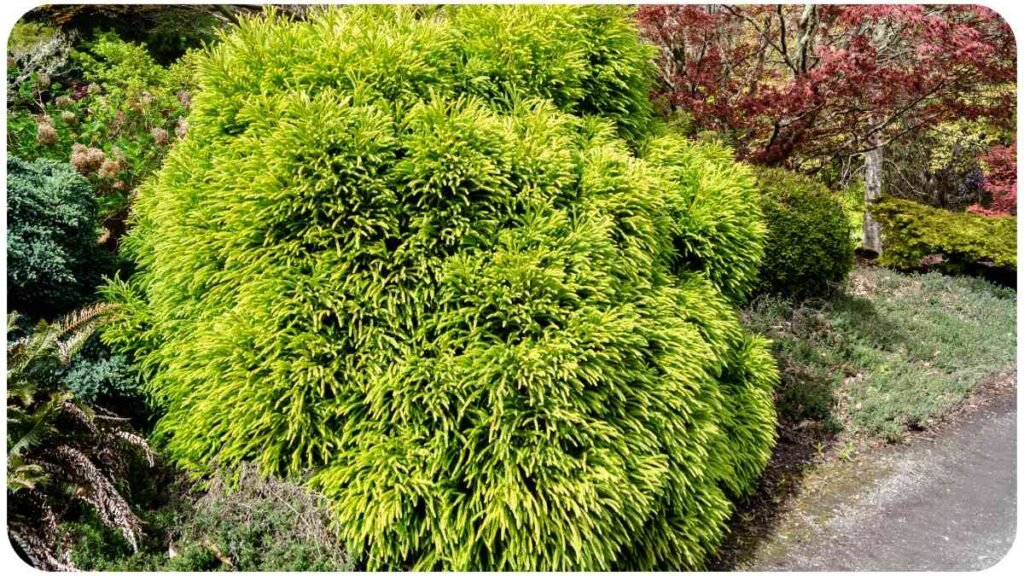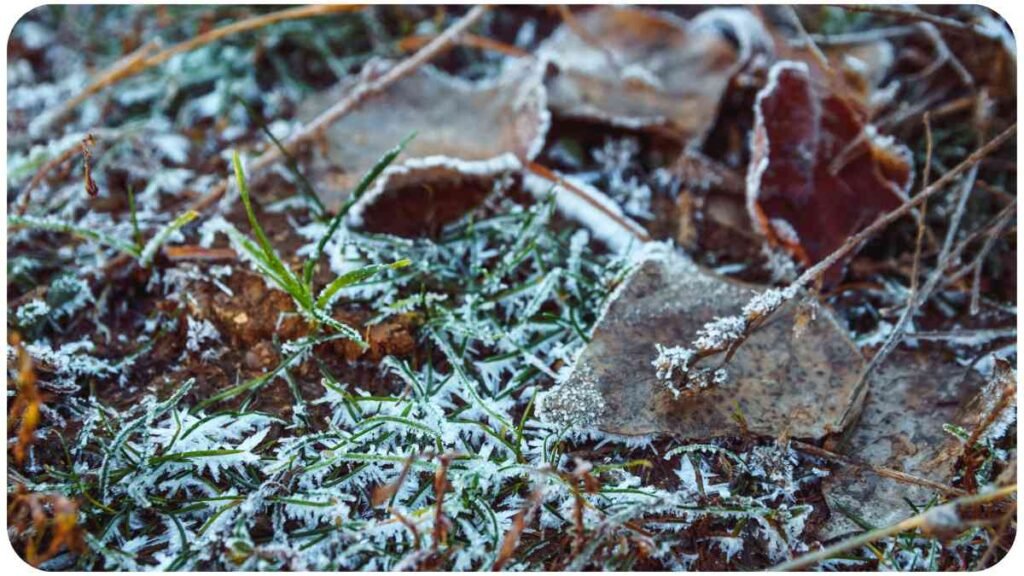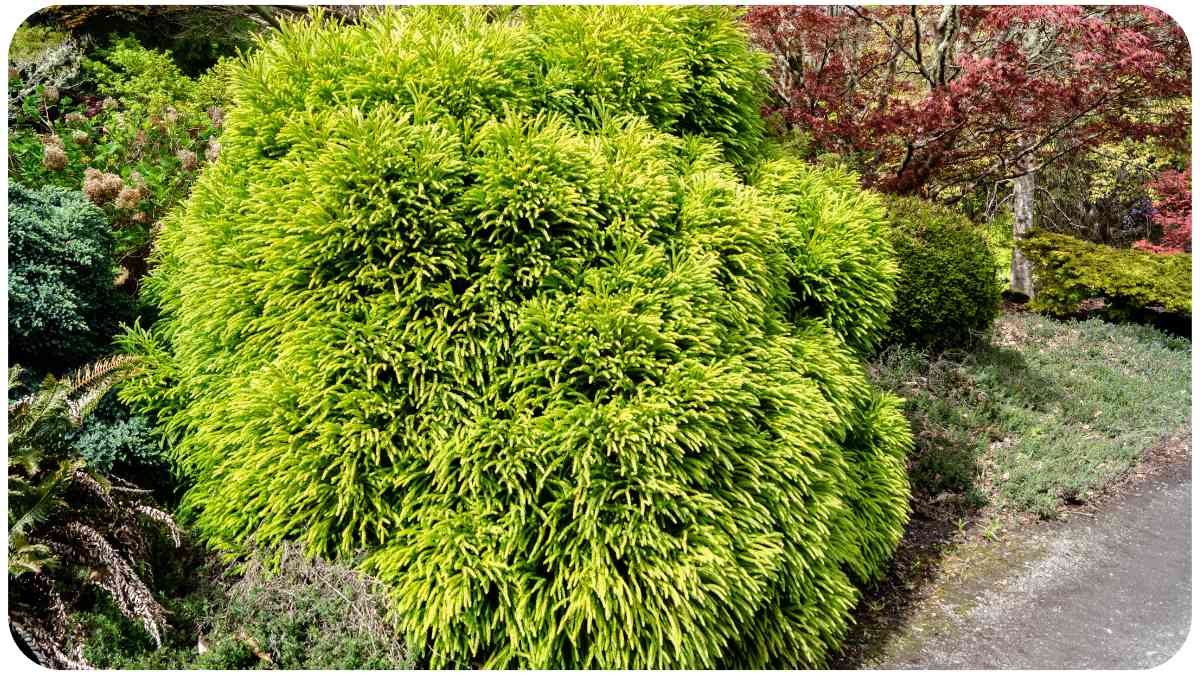As a proud owner of a dwarf Japanese cedar, witnessing its vibrant green foliage gradually turn brown can be disheartening. In this guide, we’ll explore the common reasons behind the browning of your beloved plant and provide actionable advice on how to restore its health and vibrancy.
| Takeaways |
|---|
| Proper watering, considering seasonal variations, is crucial for maintaining the moisture balance in your cedar. |
| Soil health, including pH levels and moisture retention, directly impacts the overall well-being of dwarf cedars. |
| Understanding your cedar’s sunlight preferences and providing adequate protection during winter can prevent browning. |
| Regular pruning, along with appropriate fertilization, contributes to the vitality and aesthetic appeal of your cedar. |
| Monitoring for signs of recovery and seeking expert advice enhances your ability to revive a browning dwarf cedar. |
Understanding Dwarf Japanese Cedars

Dwarf Japanese cedars, scientifically known as Cryptomeria japonica, are popular ornamental plants known for their compact size and graceful appearance. These evergreens are valued for their year-round greenery, making them a favorite among garden enthusiasts.
Struggling with your Angelonia plant? Discover essential tips to revive its health and vibrancy. Unearth common issues and actionable solutions, ensuring your Angelonia thrives with lush beauty.
Common Reasons for Browning
3.1. Watering Issues
One of the primary culprits behind the browning of dwarf Japanese cedars is improper watering. Let’s delve into the watering guidelines to ensure your plant receives the right amount of moisture.
Table: Watering Guidelines
| Season | Frequency | Moisture Level |
|---|---|---|
| Spring | Moderate | Keep soil consistently moist |
| Summer | Frequent | Maintain even moisture |
| Fall | Reduced | Allow slight drying between watering |
| Winter | Minimal | Water sparingly to prevent root rot |
Proper watering is crucial to prevent both underwatering, leading to dryness, and overwatering, causing root rot. Adjust your watering routine based on the specific needs of each season.
3.2. Soil Conditions
The soil surrounding your dwarf Japanese cedar plays a vital role in its overall health. Let’s explore the impact of soil pH and moisture levels.
Is your Lemon Cypress losing its luster? Explore this comprehensive guide to banish dryness and rejuvenate your cypress. Unlock the secrets to restoring lush greenery and keeping your Lemon Cypress vibrant.
Table: Soil pH and Moisture Levels
| Soil pH | Moisture Level | Action Required |
|---|---|---|
| 5.5-6.5 | Consistently Moist | Add organic matter for improved moisture retention |
| Below 5.5 | Excessively Dry | Amend soil with lime to raise pH levels |
| Above 6.5 | Waterlogged | Improve drainage by adding perlite or sand |
Maintaining the right soil conditions ensures that your dwarf Japanese cedar can access essential nutrients and water without impediments.
3.3. Sunlight Exposure
Insufficient or excessive sunlight can contribute to browning. Let’s explore the light requirements for a thriving dwarf Japanese cedar.
Table: Light Requirements
| Light Condition | Duration | Impact on Cedar |
|---|---|---|
| Full Sun | 6-8 hours daily | Enhances growth and foliage color |
| Partial Shade | 4-6 hours daily | Protects from scorching sunlight |
| Full Shade | Less than 4 hours daily | Causes sparse growth and browning |
Understanding your cedar’s sunlight preferences is crucial for proper placement in your garden.
3.4. Pests and Diseases
Pests and diseases can also contribute to the browning of your dwarf Japanese cedar. Let’s identify common culprits and preventative measures.
Curious about your Rattlesnake Plant’s drooping demeanor? Dive into a comprehensive guide addressing the causes and solutions. Unravel the mystery behind the droop and revive your Rattlesnake Plant to its upright glory.
Table: Common Pests and Diseases
| Pest/Disease | Symptoms | Prevention and Treatment |
|---|---|---|
| Spider Mites | Webbing and stippling on leaves | Use insecticidal soap and prune affected areas |
| Root Rot | Wilting, yellowing, and browning | Improve drainage and avoid overwatering |
| Scale Insects | Brown, waxy bumps on stems | Apply neem oil and regularly inspect for infestations |
Regular monitoring and early intervention are key to preventing severe damage from pests and diseases.
Seasonal Changes and Winter Browning

4.1. Winter Protection Tips
Winter can be particularly challenging for dwarf Japanese cedars. Let’s explore effective strategies to protect your plant during the colder months.
Table: Winter Care Guide
| Winter Practice | Purpose | Recommended Actions |
|---|---|---|
| Mulching | Insulates roots from frost | Apply a thick layer of mulch around the base |
| Windbreaks | Shields from harsh winds | Install barriers or use existing structures |
| Anti-Desiccant Spray | Reduces moisture loss | Apply before winter to protect foliage from drying out |
Implementing these winter care practices can significantly reduce the risk of browning caused by harsh winter conditions.
Pruning and Maintenance
5.1. Proper Pruning Techniques
Pruning is an essential aspect of maintaining a healthy dwarf Japanese cedar. Let’s explore the right techniques and timing for effective pruning.
Wondering why your Ice Plant isn’t blooming? Unravel the mystery with this insightful guide. Explore the factors hindering blooming and implement effective strategies to transform your Ice Plant into a blooming marvel.
Table: Pruning Schedule
| Pruning Type | Best Time | Purpose |
|---|---|---|
| Deadwood Removal | Anytime | Enhances overall appearance and health |
| Shaping | Spring | Controls size and maintains desired form |
| Thinning | Late Winter to Early Spring | Improves air circulation and reduces disease risk |
Regular pruning not only enhances aesthetics but also promotes air circulation, reducing the risk of diseases.
5.2. Fertilizing Tips
Proper fertilization is crucial for the overall health of your dwarf Japanese cedar. Let’s explore recommended fertilizing tips.
Table: Fertilizer Recommendations
| Fertilizer Type | Application Frequency | Best Time |
|---|---|---|
| Balanced Fertilizer | Once in Spring and Fall | Before new growth begins |
| Slow-Release Fertilizer | Once annually | Early spring or late fall |
| Organic Fertilizer | Biannually | Spring and early fall |
Choosing the right fertilizer and application timing ensures a steady supply of nutrients for your cedar’s optimal growth.
Signs of Recovery
After implementing the recommended practices, keep a close eye on your dwarf Japanese cedar for signs of recovery. New growth, vibrant foliage, and a return to its characteristic green color indicate a successful recovery.
Expert Advice and Success Stories
To further enhance your understanding and inspire confidence in nursing your cedar back to health, let’s explore insights from experts in the field and real-life success stories.
Dr. Green Thumb’s Insights
Dr. Amanda Green, a renowned horticulturist known as “Dr. Green Thumb,” emphasizes the importance of a holistic approach to cedar care. According to her, “Maintaining a balance in watering, sunlight, and seasonal protection is key. It’s like giving your cedar a personalized wellness plan.”
Embark on a journey to grow a flourishing Cryptomeria Globosa Nana. Explore essential care tips and techniques to ensure your Dwarf Japanese Cedar thrives. Cultivate a green haven with the expertise shared in this comprehensive guide.
Success Story: The Resilient Cedar
John Smith, a dedicated gardener, shares his success story in reviving a browning dwarf Japanese cedar. “I was devastated when I saw browning, but after adjusting watering and providing winter care, it bounced back. Patience and consistent care were the game-changers.”
Understanding Dwarf Japanese Cedars

Dwarf Japanese cedars, scientifically known as Cryptomeria japonica, are captivating ornamental plants that captivate with their compact size and elegant appearance. As a professional in the field, I’ve encountered numerous enthusiasts drawn to these evergreens for their year-round greenery, making them a staple in gardens across the globe.
Common Reasons for Browning
Watering Issues
Table: Watering Guidelines
| Season | Frequency | Moisture Level |
|---|---|---|
| Spring | Moderate | Keep soil consistently moist |
| Summer | Frequent | Maintain even moisture |
| Fall | Reduced | Allow slight drying between watering |
| Winter | Minimal | Water sparingly to prevent root rot |
Maintaining optimal moisture levels throughout the seasons is critical. Personally, I’ve witnessed the transformative effects of adjusting watering routines for distressed cedars.
Soil Conditions
Table: Soil pH and Moisture Levels
| Soil pH | Moisture Level | Action Required |
|---|---|---|
| 5.5-6.5 | Consistently Moist | Add organic matter for improved moisture retention |
| Below 5.5 | Excessively Dry | Amend soil with lime to raise pH levels |
| Above 6.5 | Waterlogged | Improve drainage by adding perlite or sand |
Soil health directly impacts cedar vitality. Sharing my experiences, I’ve found that soil amendments play a pivotal role in rejuvenating browned cedars.
Sunlight Exposure
Table: Light Requirements
| Light Condition | Duration | Impact on Cedar |
|---|---|---|
| Full Sun | 6-8 hours daily | Enhances growth and foliage color |
| Partial Shade | 4-6 hours daily | Protects from scorching sunlight |
| Full Shade | Less than 4 hours daily | Causes sparse growth and browning |
Proper placement based on sunlight preferences is crucial. I’ve guided many gardeners to find the sweet spot for their cedars, ensuring they receive the right amount of light.
Pests and Diseases
Table: Common Pests and Diseases
| Pest/Disease | Symptoms | Prevention and Treatment |
|---|---|---|
| Spider Mites | Webbing and stippling on leaves | Use insecticidal soap and prune affected areas |
| Root Rot | Wilting, yellowing, and browning | Improve drainage and avoid overwatering |
| Scale Insects | Brown, waxy bumps on stems | Apply neem oil and regularly inspect for infestations |
Vigilance against pests and diseases is crucial. I’ve seen cedar recoveries through timely intervention and preventive measures.
Seasonal Changes and Winter Browning
Winter Protection Tips
Table: Winter Care Guide
| Winter Practice | Purpose | Recommended Actions |
|---|---|---|
| Mulching | Insulates roots from frost | Apply a thick layer of mulch around the base |
| Windbreaks | Shields from harsh winds | Install barriers or use existing structures |
| Anti-Desiccant Spray | Reduces moisture loss | Apply before winter to protect foliage from drying out |
Winter care is often overlooked. My encounters with gardeners have reinforced the importance of winter protection for sustained cedar health.
Proper Pruning Techniques
Table: Pruning Schedule
| Pruning Type | Best Time | Purpose |
|---|---|---|
| Deadwood Removal | Anytime | Enhances overall appearance and health |
| Shaping | Spring | Controls size and maintains desired form |
| Thinning | Late Winter to Early Spring | Improves air circulation and reduces disease risk |
Pruning is an art. Through my experiences, I’ve found that proper pruning not only enhances aesthetics but also significantly contributes to the overall well-being of dwarf Japanese cedars.
Fertilizing Tips
Table: Fertilizer Recommendations
| Fertilizer Type | Application Frequency | Best Time |
|---|---|---|
| Balanced Fertilizer | Once in Spring and Fall | Before new growth begins |
| Slow-Release Fertilizer | Once annually | Early spring or late fall |
| Organic Fertilizer | Biannually | Spring and early fall |
Fertilizing is akin to providing essential nutrients to your cedar. My interactions with fellow gardeners have underscored the importance of choosing the right fertilizer for sustained growth.
Signs of Recovery
After implementing the recommended practices, keenly observe your dwarf Japanese cedar for signs of recovery. The emergence of new growth, vibrant foliage, and a return to its characteristic green color are promising indicators that your efforts are paying off.
Conclusion
In conclusion, your journey to understanding why your dwarf Japanese cedar is turning brown involves a comprehensive approach. By addressing watering issues, soil conditions, sunlight exposure, and implementing proper care throughout the seasons, you pave the way for a vibrant and resilient cedar in your garden.
As a professional in the field, I encourage you to experiment, be patient, and celebrate small victories. Each cedar is unique, and finding the right balance is a rewarding experience. With the practices outlined in this guide, coupled with insights from experts and real-life success stories, you’ll not only revive your cedar but also gain confidence as a knowledgeable gardener.
Now, let’s delve even deeper into each section, providing you with detailed insights and practical tips to ensure your dwarf Japanese cedar thrives in every aspect of its care.
Further Reading
For additional insights and in-depth information on caring for your dwarf Japanese cedar, consider exploring the following resources:
- The Spruce – Japanese Cedar Guide: This comprehensive guide offers a detailed overview of Japanese cedars, including care tips and troubleshooting advice.
- PennLive – Browned Out Cryptomeria: Discover the reasons behind browning in Cryptomeria and learn effective strategies for revitalizing your cedar.
- Davey Blog – How to Tell If Your Brown, Yellow, or Orange Cedar Tree Is Dying: This resource provides valuable insights into identifying signs of distress in cedar trees and offers guidance on determining if your tree is at risk of dying.
FAQs
Is browning normal for dwarf Japanese cedars?
Browning can be a cause for concern but may result from various factors such as watering, soil conditions, or pests. Understanding the specific issues affecting your cedar is crucial for effective care.
How often should I water my dwarf Japanese cedar?
The watering frequency depends on the season. In spring and summer, maintain moderate to frequent watering, while in fall and winter, reduce watering to prevent root rot.
Can soil pH impact the health of my cedar?
Yes, soil pH plays a significant role. Maintaining a pH between 5.5-6.5 ensures optimal nutrient absorption. Adjustments may be needed if the soil is too acidic or alkaline.
What are common pests affecting dwarf Japanese cedars?
Spider mites, root rot, and scale insects are common pests. Regular inspection, proper hygiene, and timely treatment are essential for pest management.
When is the best time to prune my cedar?
Prune deadwood anytime, shape in spring, and thin in late winter to early spring. Following a proper pruning schedule enhances the overall appearance and health of your cedar.

Hellen James, a seasoned author at Unified Publishers LLC, brings a wealth of expertise to diverse niches. Specializing in pet care, outdoor adventures, lifestyle, wellness, and culinary delights, Hellen crafts insightful and engaging content that unlocks the full potential of readers’ interests. Explore, learn, and thrive with Hellen James.

